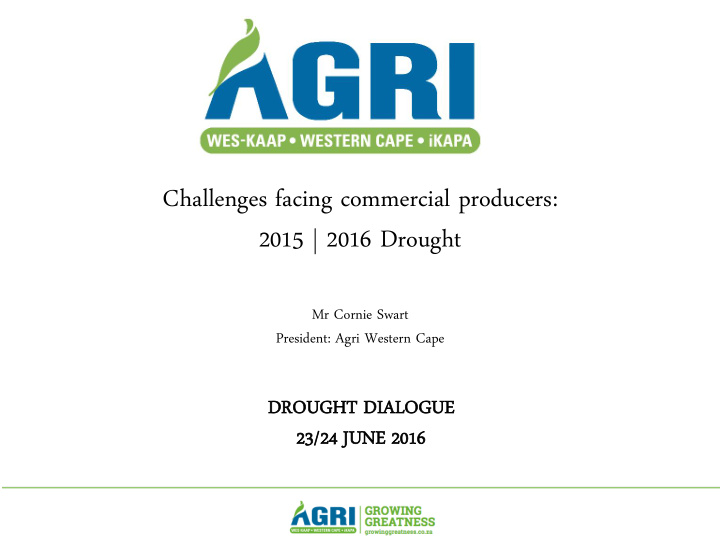



Challenges facing commercial producers: 2015 | 2016 Drought Mr Cornie Swart President: Agri Western Cape DR DROU OUGHT GHT DI DIALOG LOGUE UE 23/2 /24 4 JU JUNE 2016
Broad impact of the drought • The agricultural sector remains a key player in the province’s economy. • Drought shocks have a range of second-round effects given the strong linkages between the agricultural and other sectors. • Consequences of the drought will have adverse effects on government, consumers, organisations that do business with producers, those that rely on the agricultural sector for key inputs and the financial position of producers.
Drought relief concerns • CONCERN 1 Inadequate provisioning by national government. Funds allocated (if any) are often far below what is required. • CONCERN 2 Lack of promptness with respect to relief efforts. Assistance is often offered to farmers when it is too late. • CONCERN 3 Lack of support with operating expenses, debt restructuring and drought recovery financing. • CONCERN 4 Exclusion of crop, deciduous and wine farmers in state drought assistance efforts, noting that the majority of vulnerable farmers are uninsured.
Challenges of commercial producers • Managing climate change. • Water set aside for post-harvest used for harvest, resulting in water shortages. Will have impact on orchards for the next five years. • Water availability and management. • Extreme 2015/16 summer heat lasing well into the 2016 winter season, causing scorching and wilting in grain crops and pastures. • Required cold units in horticulture sector haven’t been met yet. • No adequate plans for water storage during good rainfall periods. • No adequate plans for storing feed for times of need. • Biosecurity measures not taken into account when moving livestock to areas with available feed.
Challenges of commercial producers • Enough water for humans and animals for the current and next season; • Enough feed to sustain small & commercial livestock producers during winter; • Potential crop losses and loss of raw materials that the value chain needs; • To keep primary producers and companies that depend on primary producers going amid economic pressure; • Debts incurred for the new season, with deferred debt from 2015.
Challenges of commercial producers • Some producers simply didn’t have enough capital to plant in 2016; • Ripple effect in terms of job creation and job maintenance; • Managing morale of producers, farm workers and residents in rural areas; • Orchards, vineyards, blooming prematurely.
RECOMMENDED ACTIONS RECOMMENDATION 1: ECONOMIC / FINANCIAL SUPPORT Introduction of interest rate subsidies and state guarantees Interest rate subsidies and state guarantees have been adopted successfully by numerous fiscally-constrained governments in their disaster relief efforts. Farmers would require the support of interest rate subsidies and/or state guarantees in two instances: 1. To service carry-over (outstanding) debt incurred as a result of crop failures. 2. To facilitate affordable production credit in the upcoming season should climatic conditions resume.
RECOMMENDATION 1: ECONOMIC / FINANCIAL SUPPORT Introduction of interest rate subsidies and state guarantees National Treasury or the Department of Agriculture, Forestry and Fisheries (DAFF) creates a mechanism in which state guarantees may be accessed, with a commitment to guarantee a portion of the carry-over debt of distressed farmers for a certain period of time.
RECOMMENDATION 2: CASH GRANTS FOR SMALL-SCALE FARMERS • A separate dispensation is proposed for farmers with an average annual turnover (5 years) of less than R100 000. • For these farmers, it is proposed that a cash grant based on historical production (for example 20% of normal annual crop) will be granted to support operating expenses and drought recovery.
RECOMMENDATION 3: DRAWING LESSONS FROM OTHER COUNTRIES AND LEARNING FROM PAST EXPERIENCES Key lessons may be drawn from • Other countries that have proven to implement successful drought relief interventions; • South Africa’s past experiences with drought relief, particular with respect to relief efforts introduced in response to the severe drought of the late 1980s and early 1990s.
RECOMMENDATION 4: CLIMATE CHANGE / RESEARCH CAPACITY • Fast track climate change initiatives. SMART AGRI detail reaction plan is welcomed and crucial. • Funding for alternative product research. • Improvement of present crops to including changing environment (crop improvement). • Expanding the Fruitlook Program for effective water management. • Additional allocation of funding for fixed assets and equipment investment • Agriculture Research Council
RECOMMENDATION 5: WATER MANAGEMENT • Revisit policies that are hampering the building of new catchment dams. • Change rules to allow for more on-farm dams. • Time consuming and costly process of Environmental Impact Assessments when building dams should be undertaken by municipalities, with participation by the agriculture sector. • Soil moisture management to ensure effective irrigation and water management. • Surveys as to the situation of underground water.
RECOMMENDATION 6: HUMANITARIAN SUPPORT / SOCIAL IMPLICATIONS • Develop plans for implementations of humanitarian need for poor and unemployed people should it arise due to the drought and economic conditions. • Revisit the use of food stamps. • Supporting of rural communities and towns
RECOMMENDATION 7: ANIMAL FEED AND HEALTH • Establish feed banks in specifically identified locations. • Organized Agriculture to take curatorship of feed banks. • Investigate alternative sources of feed for sheep. • Producers need to drive biosecurity, insist on BIOSECURITY FIRST when transporting animals to regions with available grazing. • Animal Health needs: 1. Legal support 2. Additional state veterinarians 3. Fully internationally acceptable laboratory for testing 4. Traceability
THANK YOU
Recommend
More recommend